View in other NatureServe Network Field Guides
NatureServe
Montana
Utah
Wyoming
Idaho
Wisconsin
British Columbia
South Carolina
Yukon
California
New York
Sylvan Hairstreak - Satyrium sylvinus
Native Species
Global Rank:
G4
State Rank:
S4
Agency Status
USFWS:
USFS:
BLM:
External Links
General Description
[From Ferris and Brown 1981; Scott 1986; Opler and Wright 1999; Glassberg 2001; Pyle 2002] Forewing 1.4-1.6 cm. With or without a tail (tailed in Montana). Uppersurface pale gray to brownish-gray with a bluish sheen when fresh, slight spotting of dull orange near hindwing edge; undersurface gray to brownish-gray with a postmedian row of small round white-ringed black spots, blue tail spot on hindwing lacks orange cap, a small marginal orange patch (or two) just anterior to tail spot near outer angle.
Phenology
One flight; May to June at low elevations in California, mid-July to mid-August at higher elevations and northward (Scott 1986). Late May to mid-July at lower elevations, July to mid-September at higher elevation and northward (Glassberg 2001). Early July to mid-August in Colorado (Scott and Scott 1978), Early May to early September in Oregon and Washington (Pyle 2002), mid-May to early August in Oregon (Warren 2005), mainly late June to mid-August in British Columbia (Guppy and Shepard 2001).
Diagnostic Characteristics
Best determined by a combination of uppersurface pale gray to brownish-gray with slight spotting of dull orange near hindwing edge, undersurface gray to brownish-gray with a postmedian row of small round white-ringed black spots, blue tail spot on hindwing lacks orange cap, a marginal orange patch just anterior to blue tail spot.
Species Range
Montana Range
Range Descriptions
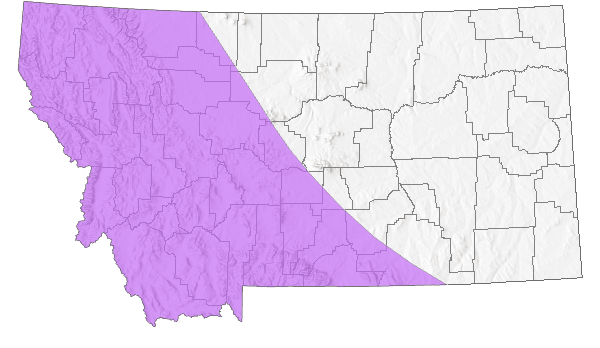
 Native
Native
Range Comments
Southern British Columbia and western Montana south to northern Baja California, southern Arizona, and central New Mexico (Scott 1986; Opler and Wright 1999; Glassberg 2001); 1830 m to 2440 m elevation in the Rocky Mountain states (Ferris and Brown 1981), 1570 m to 2560 m elevation in Colorado (Brown 1957; Scott and Scott 1978), 91 m to 2195 m elevation in Oregon (Warren 2005). In Montana, reported from 14 counties in the western 1/3 of the state, the majority west of the continental divide (Kohler 1980, Stanford and Opler 1993; FLMNH Lepidopterists' Society database). Locally uncommon to locally common (Glassberg 2001).
Observations in Montana Natural Heritage Program Database
Number of Observations: 4
(Click on the following maps and charts to see full sized version)
Map Help and Descriptions
Relative Density
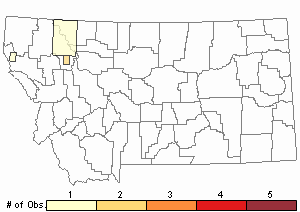
Recency
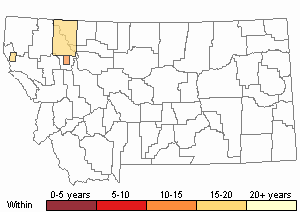
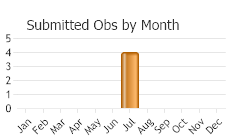

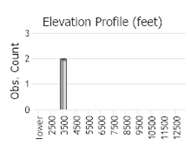 (Observations spanning multiple months or years are excluded from time charts)
(Observations spanning multiple months or years are excluded from time charts)
Migration
Non-migratory.
Habitat
Willow-lined streamsides, ditches, marshes, foothill meadows, canyons, valley bottoms (Ferris and Brown 1981; Austin 1985; Scott 1986; Opler and Wright 1999; Glassberg 2001; Pyle 2002). Habitat in Montana generally not described but probably similar; valley bottom willow-bog reported in 2012 (Butterflies and Moths of North America database).
Food Habits
Larval food plants include several species of Salix (Emmel and Emmel 1968; Ferris and Brown 1981; Scott 1986, 1992, 2006; Guppy and Shepard 2001; James and Nunnallee 2011). Adults feed on flower nectar (including Aesculus, Allium, Anaphalis, Apocynum, Asclepias, Brassica, Carduus, Centaurea, Cirsium, Clematis, Eriogonum, Melilotus, Rudbeckia) and mud (Warren 2005; James and Nunnallee 2011; Scott 2014).
Reproductive Characteristics
Females lay eggs singly, or in small clusters of 3-4 glued together, in small holes and crevices on host plant twigs and stems; eggs overwinter (Emmel and Emmel 1968; Scott 1979, 1986, 1992; James and Nunnallee 2011). Eggs hatch 3-6 days after exiting diapause (depending on temperature). Develop to L4 instar and pupate about 32-40 days post egg-hatch, adults eclose (emerge from pupae) in about 12 days (James and Nunnallee 2011). Larvae feed on leaves, build no nest, may aggregate during day in small groups on leaf undersurface, feed nocturnally and diurnally, are tended by ants in captivity (Formica pilicornis), larger larvae may cannibalize smaller ones, pupate on host plant (Scott 1986; Ballmer and Pratt 1991; James and Nunnallee 2011). Males perch from mid-morning to mid-afternoon on low vegetation near host plants in wet areas in wait of females, seldom patrol in search of females (Emmel and Emmel 1968; Scott 1975b, 1986).
Stewardship Responsibility
References
- Literature Cited AboveLegend:
 View Online Publication
View Online Publication Austin, G.T. 1985. Lowland riparian butterflies of the Great Basin and associated areas. Journal of Research on the Lepidoptera 24(2): 117-131.
Austin, G.T. 1985. Lowland riparian butterflies of the Great Basin and associated areas. Journal of Research on the Lepidoptera 24(2): 117-131. Ballmer, G.R. and G.F. Pratt. 1991. Quantification of ant attendance (myrmecophily) of lycaenid larvae. Journal of Research on the Lepidoptera 30(1-2): 95-112.
Ballmer, G.R. and G.F. Pratt. 1991. Quantification of ant attendance (myrmecophily) of lycaenid larvae. Journal of Research on the Lepidoptera 30(1-2): 95-112. Brown, F.M. 1957. Colorado Butterflies. Proceedings; Numbers Three through Seven. Denver Museum of Natural History, Denver, Co.
Brown, F.M. 1957. Colorado Butterflies. Proceedings; Numbers Three through Seven. Denver Museum of Natural History, Denver, Co. Emmel, T.C. and J.F. Emmel. 1968. Life history notes on Satyrium sylvinus dryope Edwards (Lycaenidae: Theclinae). Journal of Research on Lepidoptera. 7(2): 123-125.
Emmel, T.C. and J.F. Emmel. 1968. Life history notes on Satyrium sylvinus dryope Edwards (Lycaenidae: Theclinae). Journal of Research on Lepidoptera. 7(2): 123-125. Ferris, C.D. and F.M. Brown (eds). 1981. Butterflies of the Rocky Mountains. Univ. of Oklahoma Press. Norman. 442 pp.
Ferris, C.D. and F.M. Brown (eds). 1981. Butterflies of the Rocky Mountains. Univ. of Oklahoma Press. Norman. 442 pp. Glassberg, J. 2001. Butterflies through Binoculars: A Field Guide to the Butterflies of Western North America. Oxford University Press.
Glassberg, J. 2001. Butterflies through Binoculars: A Field Guide to the Butterflies of Western North America. Oxford University Press. Guppy, C.S. and J.H. Shepard. 2001. Butterflies of British Columbia: including western Alberta, southern Yukon, the Alaska Panhandle, Washington, northern Oregon, northern Idaho, northwestern Montana. UBC Press (Vancouver, BC) and Royal British Columbia Museum (Victoria, BC). 414 pp.
Guppy, C.S. and J.H. Shepard. 2001. Butterflies of British Columbia: including western Alberta, southern Yukon, the Alaska Panhandle, Washington, northern Oregon, northern Idaho, northwestern Montana. UBC Press (Vancouver, BC) and Royal British Columbia Museum (Victoria, BC). 414 pp. James, D.G. and D. Nunnallee. 2011. Life histories of Cascadia butterflies. Corvallis, OR: Oregon State University Press. 447 p.
James, D.G. and D. Nunnallee. 2011. Life histories of Cascadia butterflies. Corvallis, OR: Oregon State University Press. 447 p. Kohler, S. 1980. Checklist of Montana Butterflies (Rhopalocera). Journal of the Lepidopterists' Society 34(1): 1-19.
Kohler, S. 1980. Checklist of Montana Butterflies (Rhopalocera). Journal of the Lepidopterists' Society 34(1): 1-19. Opler, P.A. and A.B. Wright. 1999. A field guide to western butterflies. Second edition. Peterson Field Guides. Houghton Mifflin Company, Boston, Massachusetts. 540 pp.
Opler, P.A. and A.B. Wright. 1999. A field guide to western butterflies. Second edition. Peterson Field Guides. Houghton Mifflin Company, Boston, Massachusetts. 540 pp. Pyle, R.M. 2002. The butterflies of Cascadia: a field guide to all the species of Washington, Oregon, and surrounding territories. Seattle Audubon Society, Seattle, Washington. 420 pp.
Pyle, R.M. 2002. The butterflies of Cascadia: a field guide to all the species of Washington, Oregon, and surrounding territories. Seattle Audubon Society, Seattle, Washington. 420 pp. Scott, J.A. 1975b. Mate-locating behavior of western North American butterflies. Journal of Research on the Lepidoptera 14:1-40.
Scott, J.A. 1975b. Mate-locating behavior of western North American butterflies. Journal of Research on the Lepidoptera 14:1-40. Scott, J.A. 1979. Hibernal diapause of North American Papilionoidea and Hesperioidea. Journal of Research on the Lepidoptera 18(3): 171-200.
Scott, J.A. 1979. Hibernal diapause of North American Papilionoidea and Hesperioidea. Journal of Research on the Lepidoptera 18(3): 171-200. Scott, J.A. 1986. The butterflies of North America: a natural history and field guide. Stanford University Press, Stanford, California.
Scott, J.A. 1986. The butterflies of North America: a natural history and field guide. Stanford University Press, Stanford, California. Scott, J.A. 1992. Hostplant records for butterflies and skippers (mostly from Colorado) 1959-1992, with new life histories and notes on oviposition, immatures, and ecology. Papilio new series #6. 185 p.
Scott, J.A. 1992. Hostplant records for butterflies and skippers (mostly from Colorado) 1959-1992, with new life histories and notes on oviposition, immatures, and ecology. Papilio new series #6. 185 p. Scott, J.A. 2006. Butterfly hostplant records, 1992-2005, with a treatise on the evolution of Erynnis, and a note on new terminology for mate-locating behavior. Papilio new series #14. 74 p.
Scott, J.A. 2006. Butterfly hostplant records, 1992-2005, with a treatise on the evolution of Erynnis, and a note on new terminology for mate-locating behavior. Papilio new series #14. 74 p. Scott, J.A. 2014. Lepidoptera of North America 13. Flower visitation by Colorado butterflies (40,615 records) with a review of the literature on pollination of Colorado plants and butterfly attraction (Lepidoptera: Hersperioidea and Papilionoidea). Contributions of the C.P. Gillette Museum of Arthopod Diversity. Fort Collins, CO: Colorado State University. 190 p.
Scott, J.A. 2014. Lepidoptera of North America 13. Flower visitation by Colorado butterflies (40,615 records) with a review of the literature on pollination of Colorado plants and butterfly attraction (Lepidoptera: Hersperioidea and Papilionoidea). Contributions of the C.P. Gillette Museum of Arthopod Diversity. Fort Collins, CO: Colorado State University. 190 p. Scott, J.A. and G.R. Scott. 1978. Ecology and distribution of the butterflies of southern central Colorado. Journal of Research on the Lepidoptera 17(2): 73-128.
Scott, J.A. and G.R. Scott. 1978. Ecology and distribution of the butterflies of southern central Colorado. Journal of Research on the Lepidoptera 17(2): 73-128. Stanford, R.E. and P.A. Opler. 1993. Atlas of western USA butterflies: including adjacent parts of Canada and Mexico. Unpubl. Report. Denver and Fort Collins, Colorado 275 pp.
Stanford, R.E. and P.A. Opler. 1993. Atlas of western USA butterflies: including adjacent parts of Canada and Mexico. Unpubl. Report. Denver and Fort Collins, Colorado 275 pp. Warren, A.D. 2005. Lepidoptera of North America 6: Butterflies of Oregon, their taxonomy, distribution, and biology. Contributions of the C. P. Gillette Museum of Arthropod Diversity, Colorado State University. Fort Collins, Colorado. 406 pp.
Warren, A.D. 2005. Lepidoptera of North America 6: Butterflies of Oregon, their taxonomy, distribution, and biology. Contributions of the C. P. Gillette Museum of Arthropod Diversity, Colorado State University. Fort Collins, Colorado. 406 pp.
- Additional ReferencesLegend:
 View Online Publication
View Online Publication
Do you know of a citation we're missing? Allen, T.J., J.P. Brock, and J. Glassberg. 2005. Caterpillars in the field and garden: a field guide to the butterfly caterpillars of North America. Oxford University Press.
Allen, T.J., J.P. Brock, and J. Glassberg. 2005. Caterpillars in the field and garden: a field guide to the butterfly caterpillars of North America. Oxford University Press. Brock, J.P. and K. Kaufman. 2003. Kaufman Field Guide to Butterflies of North America. Houghton Mifflin Company, New York, NY 284 pp.
Brock, J.P. and K. Kaufman. 2003. Kaufman Field Guide to Butterflies of North America. Houghton Mifflin Company, New York, NY 284 pp. Caruthers, J.C., and D. Debinski. 2006. Montane meadow butterfly species distributions in the Greater Yellowstone Ecosystem. University of Wyoming National Park Service Research Center Annual Report, 2006. Vol. 30, Art. 14. 85-96.
Caruthers, J.C., and D. Debinski. 2006. Montane meadow butterfly species distributions in the Greater Yellowstone Ecosystem. University of Wyoming National Park Service Research Center Annual Report, 2006. Vol. 30, Art. 14. 85-96. Forister, M.L., C.A. Halsch, C.C. Nice, J.A. Fordyce, T.E. Dilts, J.C. Oliver, K.L. Prudic, A.M. Shapiro, J.K. Wilson, J. Glassberg. 2021. Fewer butterflies seen by community scientists across the warming and drying landscapes of the American West. Science 371:1042-1045.
Forister, M.L., C.A. Halsch, C.C. Nice, J.A. Fordyce, T.E. Dilts, J.C. Oliver, K.L. Prudic, A.M. Shapiro, J.K. Wilson, J. Glassberg. 2021. Fewer butterflies seen by community scientists across the warming and drying landscapes of the American West. Science 371:1042-1045. Forister, M.L., E.M. Grames, C.A. Halsch, K.J. Burls, C.F. Carroll, K.L. Bell, J.P. Jahner, et al. 2023. Assessing risk for butterflies in the context of climate change, demographic uncertainty, and heterogeneous data sources. Ecological Monographs 93(3):e1584. https://doi.org/10.1002/ecm.1584
Forister, M.L., E.M. Grames, C.A. Halsch, K.J. Burls, C.F. Carroll, K.L. Bell, J.P. Jahner, et al. 2023. Assessing risk for butterflies in the context of climate change, demographic uncertainty, and heterogeneous data sources. Ecological Monographs 93(3):e1584. https://doi.org/10.1002/ecm.1584 Layberry, R.A., P.W. Hall, and J.D. LaFontaine. 1998. The Butterflies of Canada. University of Toronto Press. 280 pp. + color plates.
Layberry, R.A., P.W. Hall, and J.D. LaFontaine. 1998. The Butterflies of Canada. University of Toronto Press. 280 pp. + color plates.
- Web Search Engines for Articles on "Sylvan Hairstreak"
- Additional Sources of Information Related to "Insects"





